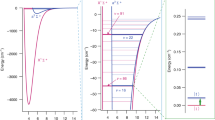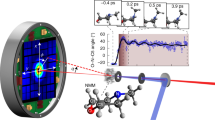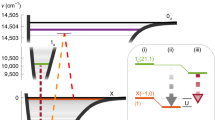Abstract
Compared with atoms, molecules have a rich internal structure that offers many opportunities for technological and scientific advancement. The study of this structure could yield critical insights into quantum chemistry1,2,3, new methods for manipulating quantum information4,5, and improved tests of discrete symmetry violation6,7 and fundamental constant variation8,9,10. Harnessing this potential typically requires the preparation of cold molecules in their quantum rovibrational ground state. However, the molecular internal structure severely complicates efforts to produce such samples. Removal of energy stored in long-lived vibrational levels is particularly problematic because optical transitions between vibrational levels are not governed by strict selection rules, which makes laser cooling difficult. Additionally, traditional collisional, or sympathetic, cooling methods are inefficient at quenching molecular vibrational motion11. Here we experimentally demonstrate that the vibrational motion of trapped BaCl+ molecules is quenched by collisions with ultracold calcium atoms at a rate comparable to the classical scattering, or Langevin, rate. This is over four orders of magnitude more efficient than traditional sympathetic cooling schemes11. The high cooling rate, a consequence of a strong interaction potential (due to the high polarizability of calcium), along with the low collision energies involved12, leads to molecular samples with a vibrational ground-state occupancy of at least 90 per cent. Our demonstration uses a novel thermometry technique that relies on relative photodissociation yields. Although the decrease in vibrational temperature is modest, with straightforward improvements it should be possible to produce molecular samples with a vibrational ground-state occupancy greater than 99 per cent in less than 100 milliseconds. Because sympathetic cooling of molecular rotational motion is much more efficient than vibrational cooling in traditional systems, we expect that the method also allows efficient cooling of the rotational motion of the molecules. Moreover, the technique should work for many different combinations of ultracold atoms and molecules.
This is a preview of subscription content, access via your institution
Access options
Subscribe to this journal
Receive 51 print issues and online access
$199.00 per year
only $3.90 per issue
Buy this article
- Purchase on Springer Link
- Instant access to full article PDF
Prices may be subject to local taxes which are calculated during checkout


Similar content being viewed by others
References
Smith, D. The ion chemistry of interstellar clouds. Chem. Rev. 92, 1473–1485 (1992)
Balakrishnan, N. & Dalgarno, A. Chemistry at ultracold temperatures. Chem. Phys. Lett. 341, 652–656 (2001)
Krems, R. V. Cold controlled chemistry. Phys. Chem. Chem. Phys. 10, 4079–4092 (2008)
André, A. et al. A coherent all-electrical interface between polar molecules and mesoscopic superconducting resonators. Nature Phys. 2, 636–642 (2006)
Schuster, D., Bishop, L., Chuang, I., DeMille, D. & Schoelkopf, R. Cavity QED in a molecular ion trap. Phys. Rev. A 83, 012311 (2011)
Kozlov, M. G. & Labowsky, L. Z. Parity violation effects in diatomics. J. Phys. At. Mol. Opt. Phys. 28, 1933–1961 (1995)
Vutha, A. C. et al. Search for the electric dipole moment of the electron with thorium monoxide. J. Phys. At. Mol. Opt. Phys. 43, 074007 (2010)
DeMille, D. et al. Enhanced sensitivity to variation of m e /m p in molecular spectra. Phys. Rev. Lett. 100, 043202 (2008)
Chin, C., Flambaum, V. V. & Kozlov, M. G. Ultracold molecules: new probes on the variation of fundamental constants. N. J. Phys. 11, 055048 (2009)
Hudson, E. et al. Production of cold formaldehyde molecules for study and control of chemical reaction dynamics with hydroxyl radicals. Phys. Rev. A 73, 063404 (2006)
Krems R. V., Stwalley W. C., Friedrich B., eds. Cold Molecules: Theory, Experiment, Applications Ch. 13, 18 (CRC, 2009)
Ferguson, E. E. Vibrational quenching of small molecular ions in neutral collisions. J. Phys. Chem. 90, 731–738 (1986)
Chou, C. W., Hume, D. B., Koelemeij, J. C. J., Wineland, D. J. & Rosenband, T. Frequency comparison of two high-accuracy Al+ optical clocks. Phys. Rev. Lett. 104, 070802 (2010)
McGuirk, J., Foster, G., Fixler, J., Snadden, M. & Kasevich, M. Sensitive absolute-gravity gradiometry using atom interferometry. Phys. Rev. A 65, 033608 (2002)
Griffith, W. et al. Improved limit on the permanent electric dipole moment of 199Hg. Phys. Rev. Lett. 102, 101601 (2009)
Levin K., Fetter A. L., Stamper-Kurn D. M., eds. Ultracold Bosonic and Fermionic Gases (Elsevier, 2012)
Shuman, E. S., Barry, J. F. & Demille, D. Laser cooling of a diatomic molecule. Nature 467, 820–823 (2010)
Hummon, M., Yeo, M., Stuhl, B., Xia, Y. & Ye, J. Direct laser cooling of yttrium monoxide. Bull. Am. Phys. Soc. 57, abstr. C2.00002. (2012)
Ostendorf, A. et al. Sympathetic cooling of complex molecular ions to millikelvin temperatures. Phys. Rev. Lett. 97, 243005 (2006)
Staanum, P. F. Højbjerre, K. Skyt, P. S., Hansen, A. K. & Drewsen, M. Rotational laser cooling of vibrationally and translationally cold molecular ions. Nature Phys. 6, 271–274 (2010)
Schneider, T., Roth, B., Duncker, H., Ernsting, I. & Schiller, S. All-optical preparation of molecular ions in the rovibrational ground state. Nature Phys. 6, 275–278 (2010)
Tong, X., Winney, A. & Willitsch, S. Sympathetic cooling of molecular ions in selected rotational and vibrational states produced by threshold photoionization. Phys. Rev. Lett. 105, 143001 (2010)
Hudson, E. Method for producing ultracold molecular ions. Phys. Rev. A 79, 032716 (2009)
Chen, K. et al. Molecular-ion trap-depletion spectroscopy of BaCl+ . Phys. Rev. A 83, 030501 (2011)
Schowalter, S. J., Chen, K., Rellergert, W. G., Sullivan, S. T. & Hudson, E. R. An integrated ion trap and time-of-flight mass spectrometer for chemical and photo-reaction dynamics studies. Rev. Sci. Instrum. 83, 043103 (2012)
Rellergert, W. et al. Measurement of a large chemical reaction rate between ultracold closed-shell 40Ca atoms and open-shell 174Yb+ ions held in a hybrid atom-ion trap. Phys. Rev. Lett. 107, 243201 (2011)
Sullivan, S. T., Rellergert, W. G., Kotochigova, S. & Hudson, E. R. Role of electronic state excitation in ground-state-forbidden inelastic collisions between ultracold atoms and ions. Phys. Rev. Lett. 109, 223002 (2012)
DeVoe, R. Power-law distributions for a trapped ion interacting with a classical buffer gas. Phys. Rev. Lett. 102, 063001 (2009)
Band, Y. & Julienne, P. Optical-Bloch-equation method for cold-atom collisions: Cs loss from optical traps. Phys. Rev. A 46, 330–343 (1992)
Major, F. G. & Dehmelt, H. G. Exchange-collision technique for the rf spectroscopy of stored ions. Phys. Rev. 170, 91–107 (1968)
Leanhardt, A. et al. High-resolution spectroscopy on trapped molecular ions in rotating electric fields: a new approach for measuring the electron electric dipole moment. J. Mol. Spectrosc. 270, 1–25 (2011)
Lefebvre-Brion, H. & Field, R. W. The Spectra and Dynamics of Diatomic Molecules Ch. 5 (Academic, 2004).
Acknowledgements
This work was supported by ARO grant no. W911NF-10-1-0505, US NSF grant nos PHY-1005453 and PHY-1205311, and AFOSR grant no. FA 9550-11-1-0243.
Author information
Authors and Affiliations
Contributions
E.R.H., W.G.R. and S.T.S. conceived of the thermometry technique and measurement protocol. W.G.R. and S.T.S. built the MOTion trap apparatus, wrote the data acquisition software, and acquired and analysed all data in Fig. 2. S.J.S. built the time-of-flight apparatus, acquired and analysed the data in Fig. 1, and helped K.C. write the data acquisition software for these data. S.K. calculated the potential energy curves and dipole moment for the BaCl+ molecules as well as the relevant absorption, spontaneous and stimulated emission rates due to black-body radiation. S.J.S. prepared all of the figures. W.G.R. wrote the manuscript with input from all authors.
Corresponding author
Ethics declarations
Competing interests
The authors declare no competing financial interests.
Supplementary information
Supplementary Information
This file contains Supplementary Figure 1 and Supplementary Text. The figure shows a detailed schematic of the experimental apparatus and a set of colourised images from the experiment, and the Supplementary Text discusses the suitability of the model of photodissociative thermometry and the effect of collisions involving excited state Ca atoms. (PDF 810 kb)
PowerPoint slides
Rights and permissions
About this article
Cite this article
Rellergert, W., Sullivan, S., Schowalter, S. et al. Evidence for sympathetic vibrational cooling of translationally cold molecules. Nature 495, 490–494 (2013). https://doi.org/10.1038/nature11937
Received:
Accepted:
Published:
Issue Date:
DOI: https://doi.org/10.1038/nature11937
This article is cited by
-
Laser-induced forced evaporative cooling of molecular anions below 4 K
Nature Physics (2023)
-
Roaming pathways and survival probability in real-time collisional dynamics of cold and controlled bialkali molecules
Scientific Reports (2021)
-
Effects of conical intersections on hyperfine quenching of hydroxyl OH in collision with an ultracold Sr atom
Scientific Reports (2020)
-
The effect of the electric trapping field on state-selective loading of molecules into rf ion traps
Scientific Reports (2020)
-
Long-range versus short-range effects in cold molecular ion-neutral collisions
Nature Communications (2019)
Comments
By submitting a comment you agree to abide by our Terms and Community Guidelines. If you find something abusive or that does not comply with our terms or guidelines please flag it as inappropriate.



